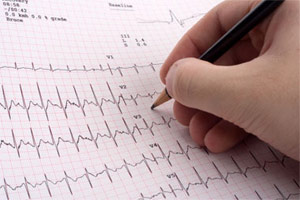
What to expect at the hospital
You've been having chest pain, discomfort, or other signs of heart attack, so you called 911. Now what?
The emergency medical technicians can begin diagnosis and treatment right away if needed. Once at the hospital, doctors will do tests to see if you've had a heart attack and what kind of damage you may have:
- Blood tests — Doctors can use blood tests to see if you've had a heart attack. The tests measure substances that are released into the blood when heart cells die. The amount released into your blood also tells how much damage was done to your heart. These tests may be repeated over time to check for changes.
- Electrocardiogram (ECG or EKG) — An EKG or ECG measures the rate and regularity of your heartbeat.
- Imaging tests — Several types of tests can help doctors "see" the heart and look for problems, such as heart damage, blockages, problems with blood flow, and problems with the heart's pumping action.
lf you've had or are having a heart attack, the blood flow to your heart needs to be restored. The doctors may use clot-busting drugs or emergency procedures to open up or bypass blocked or narrowed arteries. Once your condition is stable, your doctor will talk to you about next steps. This might involve more testing, surgery, taking medicines, and lifestyle changes
More information on what to expect at the hospital
Explore other publications and websites
-
Cardiac MRI — This fact sheet discusses what a cardiac MRI is and how it is used to evaluate heart problems, including coronary heart disease, heart failure, and heart defects.
http://www.nhlbi.nih.gov/health/dci/Diseases/mri/mri_whatis.html
-
Creatine Kinease (Copyright © American Association for Clinical Chemistry) — This publication explains the creatine kinase test and how it is used to detect signs and symptoms of a heart attack.
http://www.labtestsonline.org/understanding/analytes/ck/test.html
-
Echocardiography — This online publication explains what echocardiograms are, how they work, and who should get them. It also describes the different types of echocardiogram in use, what type of information it can provide, and how the procedure is performed.
http://www.nhlbi.nih.gov/health/dci/Diseases/echo/echo_whatis.html
-
Myoglobin (Copyright © American Association for Clinical Chemistry) — This publication explains the myoglobin test and how it is used to help diagnose and treat a heart attack.
http://www.labtestsonline.org/understanding/analytes/myoglobin/test.html
-
Stress Testing — Stress tests are often used to diagnose coronary heart and artery diseases and it gives your doctor an idea of how your heart functions during physical stress. This publication discusses how stress tests are administered to patients and how they are used to diagnose heart disease.
http://www.nhlbi.nih.gov/health/dci/Diseases/stress/stress_whatis.html
-
Tissue Plaminogen Activator (Copyright © American Heart Association) — There are several drugs and agents that health professionals can use to help treat heart attacks and stroke. This publication discusses how tissue plaminogen activator (tPA) is used to stop heart attacks and strokes.
http://www.strokeassociation.org/STROKEORG/AboutStroke/Treatment/Treatment_UCM_310892_Article.jsp
Connect with other organizations
-
American Association for Clinical Chemistry
http://www.aacc.org/Pages/default.aspx
-
American Heart Association
http://www.heart.org/HEARTORG/
-
National Center for Chronic Disease Prevention and Health Promotion, CDC
http://www.cdc.gov/chronicdisease/index.htm
-
National Institute of Neurological Disorders and Stroke, NIH, HHS
http://www.ninds.nih.gov/
Content last updated February 1, 2009.
Resources last updated February 1, 2009.
womenshealth.gov
A federal government website managed by the Office on Women's Health in the Office of the Assistant Secretary for Health at the U.S. Department of Health and Human Services.
200 Independence Avenue, S.W. • Washington, DC 20201


 Text size
Text size Email
Email
